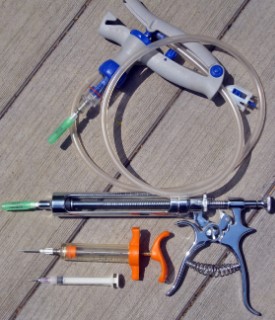By Dr. J. Bret Taylor
Lambing season is upon us or soon will be! Whether just beginning, in the midst of, or wrapping up lambing, lamb survival is a concern for all of us. The U.S. Department of Agriculture recently reported that the average death rate of lambs from birth through weaning to be nearly 11%! Most of these lambs are lost in the first two weeks of life.

Many troublesome diseases plague neonatal (new-born) lambs. One of these diseases is caused by Clostridium perfringens Type C, which results in bloody scours (diarrhea). Another strain of C. perfringens, Type D, rears its ugly head beginning several weeks after birth when the ewe’s milk production is high and/or lambs gain access to concentrate-type feeds (grain-based supplements or diets). Death caused from either type of C. perfringens can be sudden, and overall mortality can be disturbingly high. Regardless of the causative strain of C. perfringens or the age of the lamb, enterotoxemia is the name of the disease. Realize that lambs are at risk of contracting enterotoxemia from birth through post weaning.
A number of management strategies can be used to minimize enterotoxemia in our lamb flocks. The most important strategy is VACCINATION. Before diving into specific strategies regarding C. perfringens, let’s take a moment to discuss vaccination in general. The procedural “steps” for an effective vaccination program are: the primary, the secondary and the booster vaccination. The primary is when the animal receives the first injection of a specific vaccine, which alerts the animal’s immune system that a new invader is in town. The immune system engages in a series of complex processes to recognize this new invader and then initiates production of specific antibodies to neutralize the invader. The secondary is a follow-up vaccination of the same vaccine that was used for the primary. Depending upon the manufacture’s recommendation, the secondary vaccination may occur two to six weeks after the primary. The secondary alerts the immune system that the invader is back. In turn, the immune system up-regulates production of specific antibodies against the invader and locks in a long-term “memory” of that specific invader. Just to be clear, the immune system doesn’t really have a memory like our brain. However, the animal’s cells that were responsible for creating the specific antibody that neutralized the invader are maintained for a long time. Last but not least is the booster. The booster tells the animal’s immune system that the threat of the invader always remains. All retained animals should receive an annual booster of the vaccine product.
Let’s get back to enterotoxemia and C. perfringens. Several vaccine products, such as a 3-way, 7-way or 8-way, are available that target a combination of multiple Clostridium organisms. Whatever vaccine you select, make sure “Clostridium perfringens Type C & D” is listed in the mix of targeted organisms. As a side note, make sure Clostridium tetani is in there, too! To minimize enterotoxemia occurrence in neonatal lambs, first and foremost, pregnant ewes should receive a booster vaccination of the vaccine around four weeks before lambing. Referring back to our discussion about the steps of vaccination, a booster vaccination requires that the ewes should have received a primary and secondary vaccination earlier in life; in other words, when they were lambs. When ewes receive a booster near lambing, antibodies that neutralize C. perfringens are greatly increased in the ewes’ blood. In turn, these antibodies are concentrated in the colostrum that is delivered to the lamb right after birth. This is call “passive immunity.” It’s important to recognize that ruminants (sheep, cattle, goats, etc.) are born without a functional immune system. Therefore, their early-life immunity is entirely dependent upon the antibodies received from the colostrum of their mother.
Lambs begin to develop a functional immune system around four weeks of age, give or take a week. Therefore, for those that wish to start vaccinating for C. perfringens early, the most effective strategy is to wait a few weeks after birth. Again, the secondary should follow two to six weeks later depending on the manufacturer’s recommendation. Now, I can already hear several readers challenging me on waiting until four weeks of age instead of vaccinating at birth. I hear you, and I also recognize that many professionals out there recommend vaccinating within the first week of birth. Please understand that I’m not challenging these professionals. However, research data (see recommended readings) strongly indicate that lambs will respond best to vaccinations if the primary is delivered when the lamb is around four weeks of age. If you are one of those that vaccinate lambs within the first week of birth, please, please don’t skip the secondary that should occur very soon after. Some range producers do not give the primary vaccination until lambs are three to four months of age, near or around weaning. That’s okay, too. Just remember that your vaccination strategy for C. perfringens should be customized to fit your operation and when the greatest risk of enterotoxemia occurs. I cannot overemphasize enough, however, the importance of an annual (never skipped) booster vaccination program for your late pregnant ewes.
Source : osu.edu